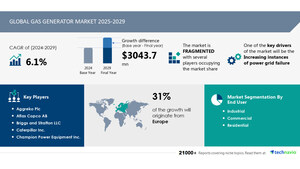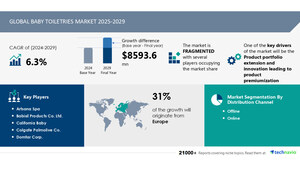NEW YORK, Sept. 9, 2024 /PRNewswire/ -- Report with market evolution powered by AI- The global e-textile market size is estimated to grow by USD 26.33 billion from 2024-2028, according to Technavio. The market is estimated to grow at a CAGR of 40.09% during the forecast period. High demand for health-monitoring wearables is driving market growth, with a trend towards increasing adoption of ble technology and miniaturization of electronic components. However, high manufacturing cost poses a challenge. Key market players include AiQ Smart Clothing Inc., B10NIX Srl, BAE Systems Plc, BeBop Sensors Inc., Carre Technologies Inc., DuPont de Nemours Inc., Interactive Wear AG, Jabil Inc., LOOMIA, Mitsufuji Corp, Outlast Technologies GmbH, sanSirro GmbH, Schoeller Textil AG, Sensoria Inc., Statex Production and Sales GmbH, Tex Ray Industrial Co. Ltd., ThermoSoft International Corp., Toray Industries Inc., Vulpes Electronics GmbH, and Xenoma Inc..
AI-Powered Market Evolution Insights. Our comprehensive market report ready with the latest trends, growth opportunities, and strategic analysis- View your snapshot now
Forecast period |
2024-2028 |
Base Year |
2023 |
Historic Data |
2018 - 2022 |
Segment Covered |
Application (Passive and Active), End-user (Military and defense, Architecture, Sports and fitness, Transportation, and Others), and Geography (North America, Europe, APAC, South America, and Middle East and Africa) |
Region Covered |
North America, Europe, APAC, South America, and Middle East and Africa |
Key companies profiled |
AiQ Smart Clothing Inc., B10NIX Srl, BAE Systems Plc, BeBop Sensors Inc., Carre Technologies Inc., DuPont de Nemours Inc., Interactive Wear AG, Jabil Inc., LOOMIA, Mitsufuji Corp, Outlast Technologies GmbH, sanSirro GmbH, Schoeller Textil AG, Sensoria Inc., Statex Production and Sales GmbH, Tex Ray Industrial Co. Ltd., ThermoSoft International Corp., Toray Industries Inc., Vulpes Electronics GmbH, and Xenoma Inc. |
The e-textile market is experiencing significant growth due to the integration of Bluetooth Low Energy (BLE) technology into textiles. BLE is a wireless personal area network technology commonly used in devices like smartphones, tablets, and laptops. It enables multi-vendor interoperability and low power consumption. The textile industry is now integrating this technology into fabrics, allowing for garments to sense and monitor data when connected to the internet. Additionally, BLE technology reduces power consumption compared to other power sources. The miniaturization of electronic components is a key trend, driving the need for smaller assembly components in e-textile manufacturing. Traditional textile cores are integrated with electronic components for various applications, such as sports performance monitoring, healthcare, and transportation. These electronic materials consist of passive components like conductors and resistors, as well as active components like transistors and diodes. Advancements in wireless and electronic technologies have made miniaturization possible and enabled their integration into conductive textiles. The high growth of the e-textile market is a result of the technological advances in small-sized components used in the manufacture of smartphones, tablets, and e-textiles. This miniaturization is leading to the development of wearable systems and making them more feasible, thereby driving market growth during the forecast period.
The e-textile market is experiencing significant growth, merging the worlds of electronics and textiles. Smart textile products, including heated blankets and clothing, bandages, bed linen, and industrial fabrics, are gaining popularity. Metals, polymers, fibres, and yarns are key materials, with emerging materials like conductive fibres and sensors playing an increasingly important role. Brands are exploring lightweighting and cross compatibility for equipment suitability. Heated clothing and textile lighting are trends in consumer markets, while biometric monitoring and haptic suits are emerging in medical and healthcare, sports and fitness, military and space, enterprise, PPE, fashion, home e-textiles, animal wearables, and automotive interiors. Market sectors face challenges such as materials availability, overhead costs, and ensuring compatibility with traditional electronics. Proposed application areas continue to expand, including motion capture and textile lighting.
Insights on how AI is driving innovation, efficiency, and market growth- Request Sample!
- E-textiles are more expensive than traditional textiles due to the integration of electronic components and technologies like nanotechnology and Bluetooth Low Energy (BLE). The high research and development costs associated with these advanced technologies contribute to the higher price point. E-textiles are created by integrating electronic components into woven fabrics or textiles. Production costs for these fabrics have risen due to the increasing demand for advanced textiles and the complexity of the manufacturing process. Additionally, the textile industry has seen an increase in employment due to increased sales volume and production costs. Asian apparel producers have experienced a 5% increase in minimum wage since January 2016, which will further increase the cost of producing e-textiles. As a result, the global e-textile market may experience slower growth during the forecast period due to the increased production costs.
- The e-Textile market is experiencing significant growth due to the emergence of new materials like conductive fibers and sensors. However, challenges persist in areas such as sensors, connectors, and traditional electronics compatibility. Brands seek lightweighting solutions for textile lighting and biometric monitoring applications. Soldiers and athletes benefit from e-Textiles in various sectors, including medical and healthcare, sports and fitness, military and space, enterprise, PPE, fashion, home textiles, animal wearables, automotive interiors, motion capture, haptic suits, and assistive clothing. New form factors for body-worn devices and emerging technology ecosystems, including conductive inks, wearable technology, printed electronics, and flexible sensors, are driving innovation. Market sectors like healthcare, prevention of diseases, road safety, and the Internet of Things offer immense potential. Despite these opportunities, challenges remain in materials availability, overhead costs, and equipment suitability. Incumbent options and proposed application areas continue to evolve, requiring careful consideration for market success.
Insights into how AI is reshaping industries and driving growth- Download a Sample Report
This e-textile market report extensively covers market segmentation by
- Application
- 1.1 Passive
- 1.2 Active
- End-user
- 2.1 Military and defense
- 2.2 Architecture
- 2.3 Sports and fitness
- 2.4 Transportation
- 2.5 Others
- Geography
- 3.1 North America
- 3.2 Europe
- 3.3 APAC
- 3.4 South America
- 3.5 Middle East and Africa
1.1 Passive- Passive e-textiles are a first-generation smart fabric segment with the capability to sense environmental conditions due to integrated sensors. These include conductive fabrics and optical fiber-embedded fabrics. Passive smart materials consist of sensors such as thermal and electrical resistive components. In the global market, these fabrics are utilized in outdoor apparel and medical wearables. For instance, a passive e-textile cooling fabric does not actively cool but regulates body temperature based on external environmental temperature, enhancing sweat evaporation. Similarly, passive e-textiles provide anti-microbial, anti-static, and UV protective properties to clothing. UV protective passive elements, like UV absorbers and optical brighteners, are added to clothing fibers for sun-protective or UV-protective functions. When combined with other technical components, these elements offer enhanced protection against skin damage. Anti-microbial composite coatings are used in manufacturing activewear, such as athletic wear, to prevent bacterial growth caused by perspiration. Vendors like Sun Dream Enterprise Co. Ltd. Offer Far Infrared Radiation Fabric and Silver Ions Antimicrobial Fabric for athletic wear production. These applications of passive e-textiles are expected to fuel segment growth during the forecast period.
Download complimentary Sample Report to gain insights into AI's impact on market dynamics, emerging trends, and future opportunities- including forecast (2024-2028) and historic data (2018 - 2022)
Electronic textiles, also known as e-textiles, represent the fusion of textiles and electronics. These innovative materials integrate various components such as sensors, connectors, and conductive fibers directly into textiles, resulting in smart textile products. The market encompasses a wide range of applications, from heated clothing and blankets to industrial fabrics and bandages. The integration of metals, polymers, fibers, and yarns creates emerging materials with unique properties. Heated clothing and bed linen offer comfort and warmth, while textile lighting adds a functional and aesthetic dimension. Biometric monitoring and cross compatibility with traditional electronics expand the potential uses of e-textiles. Lightweighting and the suitability of equipment for various industries are crucial factors. Materials availability and manufacturing practices are essential considerations for the growth of this dynamic market. E-textiles offer numerous benefits, including improved functionality, comfort, and safety. The integration of sensors and connectors enables real-time monitoring and control, making them ideal for applications in various industries, including healthcare, military, and consumer goods. The future of e-textiles holds immense potential for innovation and growth.
Electronic textiles, also known as e-textiles, represent the fusion of textiles and electronics. These innovative materials integrate various components such as sensors, connectors, and conductive fibers into textiles, resulting in smart textile products. The market encompasses a wide range of applications, from heated blankets and clothing to bandages, bed linen, industrial fabrics, and more. Emerging materials like metals, polymers, fibers, and yarns are employed in the manufacturing of e-textiles. Sensors and connectors enable functionality like biometric monitoring and cross compatibility with traditional electronics. Lightweighting and new form factors are key trends, with applications spanning various sectors including medical and healthcare, sports and fitness, military and space, enterprise, PPE, fashion, home e-textiles, animal wearables, automotive interiors, motion capture, haptic suits, and assistive clothing. Emerging e-textile products include textile lighting, advanced wound care, and haptic suits. Market sectors like healthcare and fashion are seeing significant growth, with potential applications in prevention of diseases, side effects, road safety, and emerging technology ecosystems like conductive inks, wearable technology, printed electronics, and the Internet of Things. However, challenges such as materials availability, equipment suitability, overhead costs, and proposed application areas need to be addressed for the widespread adoption of e-textiles. The market is evolving rapidly, with ongoing research and development in emerging materials and technologies.
1 Executive Summary
2 Market Landscape
3 Market Sizing
4 Historic Market Size
5 Five Forces Analysis
6 Market Segmentation
- Application
- Passive
- Active
- End-user
- Military And Defense
- Architecture
- Sports And Fitness
- Transportation
- Others
- Geography
- North America
- Europe
- APAC
- South America
- Middle East And Africa
7 Customer Landscape
8 Geographic Landscape
9 Drivers, Challenges, and Trends
10 Company Landscape
11 Company Analysis
12 Appendix
Technavio is a leading global technology research and advisory company. Their research and analysis focuses on emerging market trends and provides actionable insights to help businesses identify market opportunities and develop effective strategies to optimize their market positions.
With over 500 specialized analysts, Technavio's report library consists of more than 17,000 reports and counting, covering 800 technologies, spanning across 50 countries. Their client base consists of enterprises of all sizes, including more than 100 Fortune 500 companies. This growing client base relies on Technavio's comprehensive coverage, extensive research, and actionable market insights to identify opportunities in existing and potential markets and assess their competitive positions within changing market scenarios.
Technavio Research
Jesse Maida
Media & Marketing Executive
US: +1 844 364 1100
UK: +44 203 893 3200
Email: [email protected]
Website: www.technavio.com/
SOURCE Technavio

WANT YOUR COMPANY'S NEWS FEATURED ON PRNEWSWIRE.COM?
Newsrooms &
Influencers
Digital Media
Outlets
Journalists
Opted In





Share this article